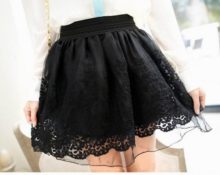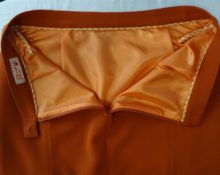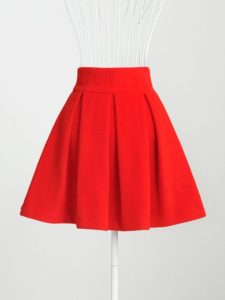 The desire to please is inherent in all women, without exception. But not everyone can afford to buy clothes from expensive brands. And is it worth it? You can always look your best provided you have a sewing machine and a little time. The main thing is to choose the right style.
The desire to please is inherent in all women, without exception. But not everyone can afford to buy clothes from expensive brands. And is it worth it? You can always look your best provided you have a sewing machine and a little time. The main thing is to choose the right style.
A pleated skirt is the perfect solution. It adds femininity and softness to the figure. Emphasizes the waist and hides narrow hips.
Even a novice dressmaker will not find it difficult to create a truly work of art. And we will teach you how to calculate and lay out folds on a skirt.
What you need to know before you start
First of all, we take measurements. When sewing a skirt we are interested in:
- waist circumference;
- hip girth;
- skirt length.
Important! Don't go wrong with the fabric yardage. For beautiful, lush folds, multiply the hip measurement by three and add 10 cm for seams and loose fit. And we increase the length measurement by 5–7 cm.
We take a measuring tape and measure the circumference of the hips at the most convex points. In our example it is 98. Add approximately 5–10 cm to the loose fit and seams. For sewing you will need a cloth of 3 meters. If the fabric width is 110, then you need to take three lengths of the skirt, taking into account the hem of the bottom. If the footage is 150, two lengths are enough.
What determines the calculation of folds
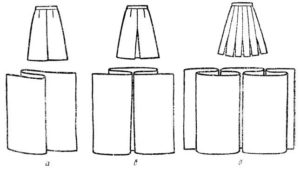
Before we begin the calculation, we decide what folds we will make: one-sided circular or bow folds. Regardless of the choice, the fabric consumption is the same, but the calculation of the main characteristics is different.
Attention! All calculations are made based on hip measurements.
The width is made to your taste: from 3 to 7 cm. If we make one-sided circular ones, then the width will be half the depth.
For example, choose a width of 5 centimeters. Using our measurements, the number of folds is equal to the sum of the hip circumference (98) plus the allowance (4), then the sum is divided by the width (5). The result is 20.
In bow folds the width doubles. Therefore, we do the calculation differently: we divide the measurement for the hips, taking into account the allowance (98+4), by the width of 10 cm. In total, we get 10 folds.
How to mark up correctly
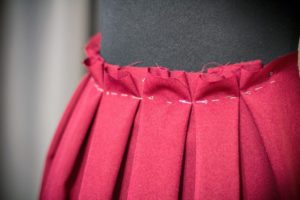
Markings are made directly on the fabric. And this is great because you don’t need to waste time creating a pattern.
We connect all the panels of fabric into a single piece. Lay out flat on the table face down. We place all marks at a distance of 18–20 cm from the top.
Circular folds
Set aside 1 cm from the side edge - it will go into the seam. It's 1/2 deep. Then we alternate width and depth. You need to finish 1/2 of the depth and plus 1 cm for the seam.
Bow pleats
For this option we mark in the following order. From the edge 1 cm - for the seam, from it ¼ depth, then alternately width and depth. We finish marking ¾ depth plus a 1 cm seam.
Important! It is necessary to apply marks so that the seam runs along half the depth of the fold. Along its inner fold. If it does not fall in the middle, then the seam needs to be moved and, leaving 1 cm, the excess should be trimmed.
Shutdown
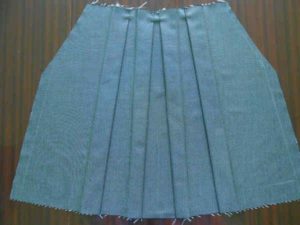
Next, you need to adjust the fold size at the waist. To do this, reduce the depth at the bottom by 1 cm on each side. Through the new points at the bottom and marks on the hips, draw a line to the waist. This will be the fold line.
We sew folds from the hip to the bottom of the skirt. We pin from the hip line to the waist. After this, we measure the width of the top of our skirt and find the difference with the waist measurement. We remove the difference evenly into the depth of each fold.
For example: the width of the panel at the hips is 102, at the waist it should be 74. The difference is 28 cm. Divide it by the required amount: 20 circular or 10 bow. This means we need to increase each waist depth by 1.4 or 2.8 cm, respectively.
We sweep the fabric according to the received marks. Be sure to double-check the width of the product at the hips and waist.
Having laid out the cloth on the table, we lay the folds in the desired direction and stitch it on top using a typewriter. After this, you can sew in the clasp and stitch the belt. The skirt is ready!
What to do if the piece of fabric is small
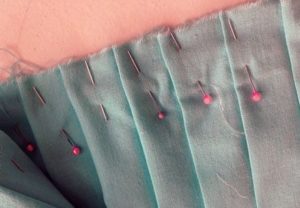
Sometimes the fabric is slightly smaller than three girths. Don't panic. We simply change the algorithm for calculating the depth of the folds. We find the difference between the total width of the stitched panel without taking into account the seam allowance and the total width and divide it by their number.
For example: (220 – 20*5):20 = 6 cm
You can decorate the folds on the skirt in different ways. Some people like soft, flowing ones. Some people prefer tougher ones. To do this, they are ironed or partially sewn up. Whichever option you choose, it will only add to your charm.Choose what you like best!


 1
1
